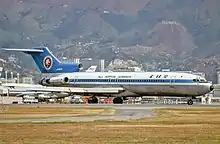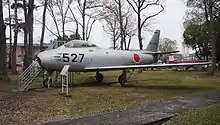All Nippon Airways Flight 58
All Nippon Airways (ANA) Flight 58 was a Japanese domestic flight from Chitose Airport to Haneda Airport, operated by All Nippon Airways (ANA). On 30 July 1971, at 02:04 local time, a Japan Air Self-Defense Force (JASDF) F-86F Sabre jet fighter collided with the Boeing 727 airliner operating the flight, causing both aircraft to crash.[1][2] All 162 people aboard the airliner were killed, while the Sabre pilot, a trainee with the JASDF, freed himself from his airplane after the collision and parachuted to safety. This incident led to the resignation of both the head of Japan's Defense Agency and the JASDF chief of staff.[3]
| Accident | |
|---|---|
| Date | 30 July 1971 |
| Summary | Mid-air collision |
| Site | near Shizukuishi, Iwate, Japan 39°41′N 140°59′E |
| Total fatalities | 162 (all on board Flight 58) |
| Total injuries | 1 |
| Total survivors | 1 |
| First aircraft | |
 An All Nippon Airways Boeing 727-200 similar to the aircraft involved in the collision | |
| Type | Boeing 727-281 |
| Operator | All Nippon Airways |
| IATA flight No. | NH58 |
| ICAO flight No. | ANA58 |
| Call sign | ALL NIPPON 58 |
| Registration | JA8329 |
| Flight origin | Sapporo-Chitose Airport (CTS/RJCC) |
| Destination | Tokyo-Haneda Airport (HND/RJTT) |
| Occupants | 162 |
| Passengers | 155 |
| Crew | 7 |
| Fatalities | 162 |
| Survivors | 0 |
| Second aircraft | |
 A preserved JASDF F-86F on display at JASDF base Nara | |
| Type | Mitsubishi F-86F Sabre |
| Operator | JASDF |
| Call sign | LILAC CHARLIE 2 |
| Registration | 92-7932 |
| Occupants | 1 |
| Passengers | 0 |
| Crew | 1 |
| Fatalities | 0 |
| Injuries | 1 |
| Survivors | 1 |
Aircraft
The ANA airliner was a Boeing 727-281[note 1] with registration JA8329; it was three months old at the time of the accident.[4] The JASDF aircraft, belonging to the 1st Air Wing at Matsushima Airbase,[3] was a Mitsubishi F-86F Sabre, a Japanese-built version of North American Aviation's famous fighter jet, with tail number 92-7932. At the time of the accident, the F-86F was one of the primary aircraft in the JASDF's inventory.
Passengers and crew
Most of the airline passengers came from Fuji in Shizuoka Prefecture and were returning from a trip to Hokkaido.[5] Of the passengers, 125 were in a tour group made up of members of a society for relatives of Japanese servicemen killed in World War II.[6] The pilot of Flight 58, Saburo Kawanishi, 41, had more than 8,000 hours of flying experience. He transmitted a brief emergency call between the time of the collision and the aircraft's disintegration.[7]
Sequence of events
ANA Flight 58 departed Chitose Airport near Sapporo, with 155 passengers and a crew of 7 on board for a domestic flight to Tokyo's Haneda International Airport. After takeoff, the aircraft climbed to its cruising altitude of about 28,000 feet (8,500 m).[4] Meanwhile, a 22-year-old JASDF trainee pilot and his instructor were practicing air combat manoeuvring in their two Sabres near Morioka, northern Honshū. The trainee, unaware of the ANA aircraft, was told by his instructor to break away from Flight 58 as it approached and banked left to avoid it, but was already too late and moments later, the leading edge of the Sabre's right wing struck the Boeing's left tailplane at an altitude of 26,000 feet (7,900 m). The damage to the Boeing's tail caused it to go out of control; it entered a steep dive and disintegrated in mid-air, the wreckage impacting near the town of Shizukuishi in Iwate Prefecture.
All 162 passengers and crew were killed. The Sabre, having lost its right wing, entered a spin that prevented the trainee pilot from ejecting, so he unbuckled his safety belts and freed himself from the aircraft. He deployed his parachute and landed safely. The Sabre plunged into a nearby rice paddy.[2][5]
Aftermath
The JASDF pilots were later tried and the trainee was acquitted on a charge of involuntary manslaughter. However, the instructor was found guilty of criminally negligent manslaughter and sentenced to three years in prison, with a three-year suspension. He also lost his job.[8][9] Keikichi Masuhara, Director-General of the Defense Agency (now Ministry of Defense) and General Yasuhiro Ueda, Chief of the Air Staff, resigned afterward to take responsibility for the incident.[3]
The loss of Flight 58 was the deadliest civil aviation disaster at the time, surpassing the 1969 crash of Viasa Flight 742,[5] and remained so until the crash of Aeroflot Flight 217 thirteen months later. It remains the deadliest accident suffered by All Nippon Airways, the second-deadliest involving a Boeing 727, behind Mexicana Flight 940,[10] and the third-deadliest on Japanese soil behind Japan Airlines Flight 123 and China Airlines Flight 140.[11] ANA still operates the flight number 58, has the same route like the accident, utilizing a Boeing 777.
See also
Notes
- The aircraft was a Boeing 727-200 model. Boeing assigns a unique code for each company that buys one of its aircraft and applies it as a suffix to the model number at the time the aircraft is built. All Nippon's code is 81, hence "727-281".
References
- Sekigawa, Eiichiro, "Mitsubishi's Mentor... ...Supersonics from Nagoya", AIR International, April 1975, Volume 8, Number 4, page 172.
- "161 Die In Worst Aviation Disaster", The Coshocton (Ohio) Tribune, July 30, 1971, page 1
- Akihiro, Sadao (2017). 自衛隊史:日本防衛政策七十年 [Self-Defense Force History: Japan's Defense Policy for Seventy Years] (in Traditional Chinese). Translated by Yida, Zhao. Eight Banners Culture, Hiking Culture. pp. 125–126. ISBN 978-986-93844-1-4.
- "Accident description, ANA Boeing 727-281 JA8329 near Shizukuishi, Japan". aviation-safety.net. Aviation Safety Network, Flight Safety Foundation. Archived from the original on 2005-03-07. Retrieved 16 July 2016.
- "Disasters: The Worst Ever". Time. 9 August 1971. Archived from the original on 1 February 2008. Retrieved 27 November 2009.
- "朝日新聞1971年8月1日" [Asahi Shimbun August 1, 1971]. The Asahi Shimbun (in Japanese). August 1, 1971.
- Simpson (2014), Part 1
- "最高裁判所第一小法廷判決 昭和53(あ)1333" [Japanese Supreme Court Minor Courtroom adjudication 1978(A)1333] (in Japanese). Retrieved 2019-07-06.
- "This Day in History: Jul 30; Fighter jet collides with passenger plane, 1971". www.history.com. A&E Television Networks. Retrieved 16 July 2016.
- Ranter, Harro. "Boeing 727". aviation-safety.net. Aviation Safety Network. Archived from the original on 2013-09-28. Retrieved 2018-10-04.
- Ranter, Harro. "Japan air safety profile". aviation-safety.net. Aviation Safety Network. Archived from the original on 2005-03-07. Retrieved 2018-10-04.
- Simpson, Paul (2014). The Mammoth Book of Air Disasters and Near Misses. London: Robinson. ISBN 978-1-78033-828-6.
External links
- "昭和47年度 運輸白書 - III 航空 第2章 航空事故 - 運輸省." [1972 White Paper on Transportation --III Aviation Chapter 2 Aviation Accidents --Ministry of Transport] (in Japanese)